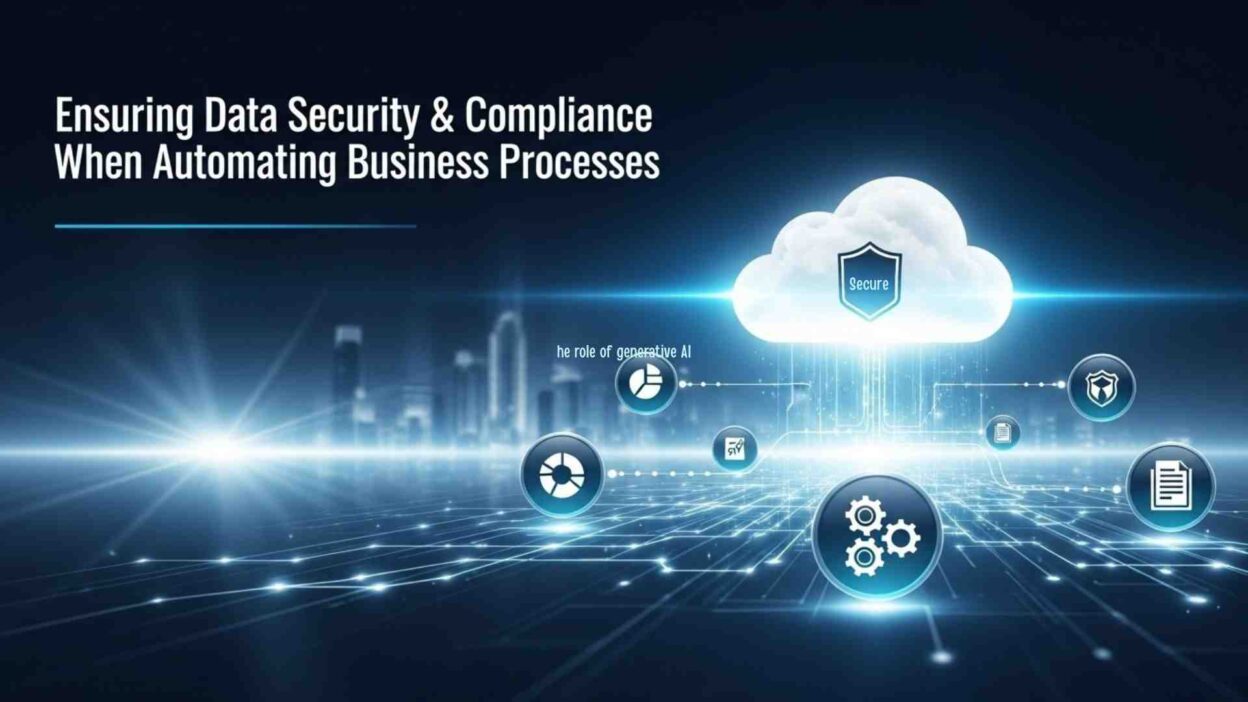Introduction
TL;DR Business automation transforms how companies operate today. Organizations adopt automated systems to boost productivity and reduce manual errors. The shift brings tremendous benefits but creates new security challenges. Data security in business process automation has become a critical concern for modern enterprises. Companies handle sensitive information daily through automated workflows. Protecting this data requires careful planning and robust security measures.
Table of Contents
Understanding the Security Landscape in Business Process Automation
Automated systems process vast amounts of information every second. Customer data flows through various touchpoints automatically. Financial records move between departments without human intervention. This efficiency comes with inherent risks that organizations must address proactively.
The Evolution of Automation Security Threats
Cyber threats have evolved alongside automation technology. Hackers now target automated workflows to access valuable business data. Traditional security measures often fall short in automated environments. Organizations face sophisticated attacks designed specifically for automated systems. Data breaches can occur at any point in the automation chain. A single vulnerability might expose entire databases to unauthorized access.
Why Data Security in Business Process Automation Matters
Your company’s reputation depends on protecting customer information. A security breach can cost millions in damages and lost trust. Regulatory penalties add financial pressure to already stressed budgets. Customers expect their data to remain confidential and secure. Competitors might gain advantages through stolen intellectual property. Business continuity relies on maintaining secure automated operations.
Core Components of Secure Business Process Automation
Building security into automation requires multiple layers of protection. Each component plays a vital role in the overall defense strategy. Understanding these elements helps organizations create robust security frameworks.
Access Control and Authentication Systems
Strong authentication prevents unauthorized users from entering your systems. Multi-factor authentication adds extra security beyond simple passwords. Role-based access ensures employees see only necessary information. Biometric verification provides additional identity confirmation when needed. Regular access reviews remove permissions from inactive accounts promptly.
Your automated systems should verify user identity before granting access. Time-based restrictions limit when certain operations can occur. Geo-fencing blocks access attempts from suspicious locations automatically. Session management logs out idle users to prevent unauthorized access. Privileged access management monitors administrator activities closely.
Encryption Standards for Automated Workflows
Encryption protects data both at rest and during transmission. Strong encryption algorithms make intercepted data useless to attackers. End-to-end encryption secures information throughout the entire automation process. Key management systems control who can decrypt sensitive information. Regular encryption audits ensure standards remain current and effective.
Data security in business process automation demands encryption at every stage. Cloud storage requires robust encryption before uploading any files. API communications need secure protocols to prevent eavesdropping attempts. Database encryption protects stored information from internal threats. Mobile devices accessing automated systems must enforce encryption policies.
Network Security Measures
Firewalls create barriers between your automation systems and external threats. Intrusion detection systems alert teams to suspicious activities immediately. Network segmentation isolates critical systems from less secure areas. Virtual private networks secure remote access to automation platforms. Regular security scanning identifies vulnerabilities before attackers exploit them.
Compliance Frameworks and Regulatory Requirements
Regulations govern how organizations handle and protect data. Compliance isn’t optional for companies operating in regulated industries. Understanding applicable laws helps avoid costly penalties and legal troubles.
GDPR and Data Protection Requirements
The General Data Protection Regulation affects any company handling EU citizen data. Organizations must obtain explicit consent before processing personal information. Data subjects have rights to access, correct, or delete their data. Breach notifications must occur within 72 hours of discovery. Penalties reach up to 4% of global annual revenue for violations.
Automated systems must incorporate privacy by design principles from inception. Data minimization ensures you collect only necessary information for operations. Purpose limitation restricts data use to originally stated purposes. Storage limitation requires deleting data when no longer needed. Data security in business process automation must align with GDPR principles throughout.
HIPAA Compliance for Healthcare Automation
Healthcare organizations face strict requirements under HIPAA regulations. Protected health information requires special safeguards in automated systems. Business associate agreements govern how third parties handle patient data. Access logs must track who views patient information and when. Encryption standards for healthcare data exceed typical business requirements.
Automated appointment scheduling systems must secure patient contact information. Electronic health records need audit trails showing all access attempts. Prescription automation requires verification protocols to prevent medication errors. Billing automation must separate financial data from medical records appropriately.
PCI DSS for Payment Processing
Payment card industry standards protect credit card information during transactions. Automated payment systems must meet twelve core requirements strictly. Network segmentation isolates payment data from other business systems. Cardholder data encryption prevents theft during processing and storage. Regular vulnerability scanning identifies potential weaknesses in payment automation.
Your automated checkout processes need secure payment gateways always. Tokenization replaces actual card numbers with useless substitutes for storage. Annual compliance assessments verify ongoing adherence to PCI requirements. Third-party processors must also maintain their PCI DSS compliance.
SOC 2 and Other Industry Standards
Service Organization Control 2 reports demonstrate security controls to clients. Trust service criteria cover security, availability, processing integrity, confidentiality, and privacy. Type II reports show controls operate effectively over time periods. Many B2B clients require SOC 2 compliance before signing contracts.
ISO 27001 certification shows commitment to information security management. Industry-specific regulations might apply depending on your business sector. State laws add additional requirements for certain types of data. International operations require compliance with multiple jurisdictions simultaneously.
Implementing Data Security in Business Process Automation
Successful implementation requires strategic planning and systematic execution. Organizations must balance security needs with operational efficiency goals. The right approach creates secure systems without hindering productivity.
Security Assessment and Risk Analysis
Begin by mapping all automated processes within your organization. Identify what data each process handles and where vulnerabilities exist. Classify data by sensitivity level to prioritize protection efforts. Assess current security controls against industry best practices carefully. Gap analysis reveals where improvements are needed most urgently.
Risk scoring helps allocate security resources to highest-priority areas. Threat modeling predicts how attackers might exploit automation vulnerabilities. Business impact analysis shows consequences of potential security failures. Regular reassessments account for new threats and changing business needs.
Choosing Secure Automation Platforms
Select automation platforms with proven security track records and certifications. Vendor security assessments reveal how providers protect your data. Look for platforms offering built-in security features rather than add-ons. Cloud-based solutions should provide transparent security documentation readily. Open-source tools require careful evaluation of community security practices.
Data security in business process automation starts with platform selection decisions. SaaS providers should maintain multiple security certifications relevant to your industry. On-premise solutions give more control but require internal security expertise. Hybrid approaches balance convenience with security requirements appropriately. Always review vendor security policies before committing to any platform.
Developing Security Policies and Procedures
Written policies establish clear expectations for all employees and contractors. Acceptable use policies define how staff can interact with automated systems. Data handling procedures specify how to process sensitive information safely. Incident response plans outline steps to take when breaches occur. Regular policy updates keep pace with evolving threats and technologies.
Security awareness training educates employees about their role in data protection. Phishing simulations test whether staff can identify social engineering attempts. Password policies enforce strong credentials and regular updates consistently. Mobile device management policies secure automation access from smartphones and tablets.
Technical Safeguards for Automated Business Processes
Technical controls form the backbone of any security strategy. Proper implementation of these safeguards significantly reduces security risks.
Secure API Integration
APIs connect different automation tools and transfer data between systems. Authentication tokens control which applications can access specific APIs securely. Rate limiting prevents abuse and potential denial-of-service attacks effectively. Input validation blocks malicious code injection attempts at API endpoints. API gateways provide centralized security monitoring and control points.
Version control ensures only current and secure API versions remain active. Deprecation policies phase out older, vulnerable API versions systematically. API documentation should include security requirements for all integrations. Regular security testing identifies vulnerabilities in API implementations before exploitation.
Database Security Measures
Databases store the valuable information that automated processes manipulate daily. Database activity monitoring tracks all queries and data access attempts. Stored procedure limitations prevent unauthorized direct database access completely. Regular backups protect against data loss from attacks or failures. Backup encryption ensures stolen backups remain useless to attackers always.
Data masking hides sensitive information in non-production environments safely. Database firewalls filter malicious queries before they reach actual data. Privileged user monitoring tracks administrator actions in database systems closely. Patch management keeps database software current against known vulnerabilities.
Secure File Transfer and Storage
Automated file transfers move documents and data between systems regularly. SFTP and FTPS protocols encrypt file transfers to prevent interception. Automated scanning checks incoming files for malware before processing begins. Temporary file cleanup removes sensitive data after processing completes successfully. Storage access controls limit who can view or modify stored files.
Data loss prevention tools monitor file movements to prevent unauthorized exports. Document retention policies automate deletion of expired files appropriately. Version control tracks changes to critical documents over time accurately. Cloud storage security settings must prevent public access to sensitive files.
Monitoring and Maintaining Security in Automated Systems
Security isn’t a one-time implementation but an ongoing process. Continuous monitoring detects threats before they cause serious damage.
Real-Time Security Monitoring
Security information and event management systems collect logs from all sources. Automated alerts notify security teams of suspicious activities immediately. Behavioral analytics identify unusual patterns that might indicate breaches. Dashboard visualization helps security teams spot trends and anomalies quickly. 24/7 monitoring ensures threats receive attention regardless of time zones.
Data security in business process automation requires constant vigilance and attention. Log aggregation centralizes security data from distributed automation components. Correlation rules identify related events that together indicate attacks. Automated response systems can block threats without human intervention needed.
Regular Security Audits and Testing
Penetration testing simulates real attacks to identify exploitable vulnerabilities. Vulnerability assessments scan systems for known security weaknesses regularly. Code reviews examine custom automation scripts for security flaws carefully. Compliance audits verify adherence to regulatory requirements and internal policies. Third-party audits provide objective assessments of security posture honestly.
Automated security testing integrates into development pipelines for continuous validation. Red team exercises test how well security teams detect and respond. Configuration audits ensure systems maintain secure settings over time consistently. Access reviews verify that user permissions remain appropriate for current roles.
Incident Response and Recovery
Incident response plans define clear roles and responsibilities during breaches. Detection mechanisms identify security incidents as quickly as possible always. Containment procedures limit damage and prevent incident spread to other systems. Eradication removes threats completely from affected systems and networks. Recovery processes restore normal operations safely after incident resolution completes.
Post-incident analysis identifies root causes and prevents future occurrences effectively. Communication protocols inform stakeholders appropriately during and after incidents. Forensic preservation maintains evidence for potential legal proceedings or investigations. Business continuity planning ensures operations continue during major security events.
Best Practices for Secure Business Process Automation
Following established best practices reduces security risks significantly over time. These guidelines come from years of industry experience and lessons learned.
Zero Trust Security Model
Assume no user or device is trustworthy by default automatically. Verify every access request regardless of source or previous authorization. Micro-segmentation limits lateral movement within your network infrastructure effectively. Least privilege principles grant minimum necessary permissions for each role. Continuous verification monitors user behavior even after initial authentication succeeds.
Data security in business process automation benefits greatly from zero trust approaches. Device health checks ensure only secure endpoints access automation systems. Context-aware access considers location, time, and device before granting permissions. Dynamic policies adjust security requirements based on risk levels automatically.
Secure Software Development Lifecycle
Security considerations must start during initial automation design phases always. Threat modeling identifies potential security issues before coding begins properly. Secure coding standards prevent common vulnerabilities from entering production systems. Code scanning tools check for security flaws throughout development processes automatically. Security testing validates controls before deployment to production environments occurs.
Change management processes review security implications of all system modifications. Deployment automation includes security verification steps before releasing updates live. Rollback procedures enable quick recovery from updates that introduce vulnerabilities. Documentation maintains records of security decisions and their justifications clearly.
Vendor and Third-Party Risk Management
Third-party vendors often access your systems to provide automation services. Vendor security assessments evaluate provider security practices before engagement begins. Contractual security requirements establish clear expectations for data protection standards. Regular vendor audits verify ongoing compliance with security agreements made. Exit strategies ensure secure data return or destruction when relationships end.
Supply chain security prevents compromised components from entering your automation stack. Software composition analysis identifies vulnerable third-party libraries in applications. Vendor security ratings help compare providers objectively based on security posture. Fourth-party risk management extends oversight to your vendors’ vendors appropriately.
Employee Training and Awareness
Human error causes many security incidents despite technical controls deployed. Regular training keeps security awareness high among all staff members. Role-specific training addresses unique risks different positions face daily. Simulated attacks test whether employees apply security knowledge in practice. Security champions within departments promote good practices among their peers.
Reporting mechanisms encourage employees to flag suspicious activities immediately without fear. Positive reinforcement rewards security-conscious behavior and incident reporting consistently. Executive buy-in demonstrates organizational commitment to security from the top down. Security culture makes data protection everyone’s responsibility throughout the organization.
Emerging Technologies and Future Security Considerations
Technology continues evolving rapidly and brings new security challenges constantly. Forward-thinking organizations prepare for future threats today while addressing current risks.
Artificial Intelligence in Security
AI-powered security tools detect threats faster than human analysts can alone. Machine learning models identify anomalies in automation patterns that indicate breaches. Predictive analytics forecast potential security incidents before they occur completely. Automated threat hunting proactively searches for hidden threats in your systems. AI reduces false positive alerts that overwhelm security teams traditionally.
Data security in business process automation increasingly relies on AI capabilities. Natural language processing analyzes security logs for threat indicators automatically. Behavioral biometrics verify user identity through typing and mouse patterns continuously. Automated incident response uses AI to contain threats within seconds.
Blockchain for Audit Trails
Blockchain technology creates immutable records of automation activities permanently. Distributed ledgers prevent tampering with audit logs after events occur. Smart contracts enforce security policies automatically without human intervention needed. Transparency allows verification of data handling across multiple parties easily. Cryptographic validation ensures log integrity throughout the record lifecycle completely.
Quantum Computing Implications
Quantum computers will eventually break current encryption standards completely. Post-quantum cryptography develops algorithms resistant to quantum attacks successfully. Organizations should plan migration strategies to quantum-safe encryption now. Crypto-agility enables quick algorithm changes when quantum threats become real. Data encrypted today might be vulnerable when quantum computers become available.
Common Security Challenges and Solutions
Organizations face similar security obstacles when automating business processes regularly. Understanding common challenges helps you avoid repeated mistakes others have made.
Legacy System Integration
Older systems often lack modern security features that current standards require. API gateways can add security layers between legacy and modern systems. Data transformation cleanses information before entering legacy systems safely. Isolation prevents legacy vulnerabilities from compromising newer automation components. Gradual modernization replaces legacy systems systematically over time when possible.
Balancing Security and Usability
Overly strict security measures frustrate users and reduce productivity significantly. User experience design considers security without creating unnecessary friction points. Adaptive authentication increases security only when risk levels warrant it. Single sign-on reduces password fatigue while maintaining strong authentication overall. Security by design incorporates protection naturally into workflows invisibly.
Resource Constraints
Small organizations struggle to maintain comprehensive security programs with limited budgets. Managed security services provide enterprise-grade protection at lower costs effectively. Cloud platforms offer built-in security features without large capital investments. Automation itself reduces security workload through automated monitoring and responses. Prioritization focuses limited resources on highest-impact security measures first.
Data security in business process automation doesn’t require unlimited budgets always. Open-source security tools provide capable alternatives to expensive commercial products. Security frameworks offer structured approaches that maximize limited resources efficiently. Shared responsibility models with cloud providers reduce internal security burdens substantially.
Compliance Complexity
Multiple regulations create overlapping and sometimes conflicting requirements difficult to manage. Compliance mapping identifies which regulations apply to specific data types. Unified control frameworks address multiple regulations with single implementations efficiently. Automated compliance monitoring tracks adherence continuously rather than during annual audits. Compliance management platforms centralize documentation and evidence collection systematically.
Measuring Security Effectiveness
You can’t improve what you don’t measure accurately and consistently. Security metrics demonstrate program effectiveness and justify continued investments needed.
Key Performance Indicators
Mean time to detect measures how quickly security teams identify incidents. Mean time to respond tracks how fast teams contain and resolve threats. Vulnerability remediation rates show how quickly discovered flaws get fixed. Security training completion rates indicate employee engagement with security programs. Compliance audit scores demonstrate adherence to regulatory requirements over time.
Security Return on Investment
Security investments prevent losses that would otherwise occur from breaches. Cost avoidance calculations estimate savings from prevented security incidents realistically. Efficiency gains from security automation reduce operational costs over time significantly. Insurance premium reductions reward strong security programs with lower rates. Competitive advantages arise from demonstrating strong security to potential clients.
Data security in business process automation delivers measurable business value beyond compliance. Reduced breach frequency lowers direct incident response and recovery costs substantially. Faster incident detection minimizes damage and associated costs per incident. Automated security controls reduce staffing requirements for routine monitoring tasks.
Frequently Asked Questions
How does data security in business process automation differ from general cybersecurity?
Business process automation creates unique security challenges that general cybersecurity doesn’t address fully. Automated workflows process data continuously without human oversight or intervention normally. This creates opportunities for threats to spread rapidly through connected systems. Traditional security measures designed for human-operated systems often prove inadequate for automation. Automated processes require real-time security monitoring and rapid response capabilities constantly. Integration points between systems create additional attack surfaces that need protection.
What are the most common security vulnerabilities in automated business processes?
Insecure APIs often provide entry points for attackers targeting automated systems. Insufficient access controls allow unauthorized users to view or modify sensitive data. Missing encryption leaves data exposed during transmission between automation components regularly. Inadequate logging prevents detection of security incidents when they occur inevitably. Poor configuration management creates security gaps as systems change over time naturally. Lack of input validation allows malicious code injection through automated forms and interfaces.
How can small businesses implement data security in business process automation affordably?
Cloud-based automation platforms include security features in their standard offerings typically. These platforms spread security costs across many customers rather than requiring individual investments. Managed security services provide expert monitoring and response at predictable monthly costs. Open-source security tools offer capable protection without licensing fees or restrictions. Automation itself reduces security workload by handling routine monitoring tasks automatically continuously. Security frameworks provide structured approaches that maximize limited resources effectively and efficiently.
What security certifications should automation platforms have?
SOC 2 Type II certification demonstrates comprehensive security controls operate effectively over time. ISO 27001 shows commitment to information security management system standards internationally. Industry-specific certifications like HIPAA or PCI DSS matter for regulated sectors particularly. Cloud Security Alliance STAR certification indicates cloud-specific security best practices compliance. Independent penetration testing reports provide evidence of security robustness under attack conditions.
How often should security assessments occur for automated processes?
Continuous monitoring provides real-time security assessment of automated systems always running. Quarterly vulnerability scans identify new security weaknesses as they emerge regularly. Annual penetration testing simulates sophisticated attacks against your automation infrastructure thoroughly. Compliance audits occur on schedules determined by specific regulatory requirements applicable. Major system changes require security reassessment before deployment to production environments.
What role does encryption play in securing automated workflows?
Encryption protects data confidentiality during storage and transmission between automation components completely. Strong encryption renders stolen data useless to attackers without proper decryption keys. End-to-end encryption ensures data remains protected throughout the entire automation process fully. Encryption at rest protects stored data from unauthorized access by insiders potentially. Encryption in transit prevents interception of data moving between systems over networks.
How can organizations ensure compliance when using cloud-based automation tools?
Review vendor compliance certifications before selecting cloud automation platforms for deployment. Shared responsibility models clarify which security controls vendors manage versus your organization. Data residency requirements must align with where cloud providers store your information. Contractual agreements should specify compliance requirements and verification rights explicitly always. Regular vendor audits verify ongoing compliance with security and regulatory requirements.
What should an automation security incident response plan include?
Clear roles and responsibilities ensure everyone knows their part during security incidents. Detection procedures identify incidents quickly through automated monitoring and alerts continuously. Containment steps limit damage and prevent incident spread to other systems rapidly. Communication protocols inform stakeholders appropriately without causing unnecessary panic or confusion. Recovery procedures restore normal operations safely after threat elimination completes successfully.
How does data security in business process automation support business continuity?
Strong security prevents incidents that would otherwise disrupt business operations significantly. Automated backups enable rapid recovery from security incidents or system failures. Redundant systems maintain operations even when primary systems experience security issues. Incident response capabilities minimize downtime when security events do occur inevitably. Security monitoring detects issues before they impact business operations or customer service.
What emerging threats should organizations watch for in business process automation?
AI-powered attacks will increasingly target automated systems with sophisticated techniques and approaches. Supply chain compromises introduce vulnerabilities through third-party automation components increasingly often. Ransomware specifically targeting automation systems could paralyze business operations completely overnight. Quantum computing will eventually threaten current encryption standards protecting automated workflows fundamentally. IoT device proliferation expands attack surfaces as more devices connect to automation systems.
Read more:-API Integration Mastery: Connecting Systems for Seamless Automation
Conclusion

Data security in business process automation represents a critical business priority today. Organizations cannot afford to overlook security when implementing automated workflows and systems. The benefits of automation are undeniable but come with significant security responsibilities. Protecting sensitive data requires comprehensive security strategies implemented thoughtfully and consistently.
Success demands balancing security requirements with operational efficiency goals carefully always. Technical controls provide the foundation but human factors remain equally important. Continuous monitoring and improvement ensure security keeps pace with evolving threats. Compliance with regulations protects organizations from legal and financial penalties substantially.
The investment in data security in business process automation pays dividends long term. Prevented breaches save millions in direct costs and reputational damage combined. Customer trust grows when organizations demonstrate commitment to data protection seriously. Competitive advantages arise from security certifications and proven security track records.





